#house construction cost estimation
Text
Gruhom offer House construction in Bangalore Starting at Just Rs 1550/ sq ft onwards; We helps you get exact estimates of construction cost. Contact us: +91 9845208299
#house construction cost estimation#building construction cost estimation#estimate house construction#construction cost calculator bangalore#house construction companies in bangalore#building contractors bangalore#construction contractors in bangalore#best house construction companies in bangalore#build a home bangalore
1 note
·
View note
Text
Construction cost estimator with Many Years of experience. Sydney Estimator offers building & construction cost estimating services. FREE consultation!
#estimating construction#construction estimating#estimating construction costs#construction cost#construction consultant#cost of building a house
1 note
·
View note
Text
Building a new home is a monumental undertaking that requires meticulous planning, skilled execution, and a keen eye for detail. From the initial concept to the final coat of paint, every step in the construction process plays a vital role in creating a safe, functional, and beautiful living space.
In this comprehensive guide, we will take you through the entire step-by-step process of new home construction, highlighting each phase's significance, offering tips and tricks, and providing additional insights to help you navigate this exciting journey.
Understanding the New Home Construction Process
Constructing a new home is a multi-faceted endeavour that demands coordination, expertise, and careful consideration. Let us dive into the comprehensive step-by-step guide to new home construction.
#civil engineering#construction news#civil construction#structural engineering#engineering#house construction cost estimate
1 note
·
View note
Text
https://aashiyana.tatasteel.com/in/en/buy-our-products.html?utm_source=Backlink&utm_medium=Offpage+Submission&utm_campaign=Offpage+Backlink+Submission&utm_id=seo_referral_backlink#buy-building-materials-online
Buy home plans & building supplies online. We provide the best-priced home design & construction materials all over India. Visit https://aashiyana.tatasteel.com/in/en/buy-our-products.html for more details
#house design#railing design#steel railing design#balcony railing design#new home design#new house design#house gate design#house construction#house railing designs#house construction cost#steel doors and windows#house construction materials#house construction cost estimator#construction material suppliers near me#material required for house construction#buy construction steel online
0 notes
Text
#Planning To Build a House#9 tips to reduce construction cost#construction cost#construction cost estimation#construction cost for a house#will construction cost go down in 2022
0 notes
Text
At the end of January, clips from a film about the housing market in Russian-occupied Mariupol began circulating on TikTok and X (formerly Twitter). After the start of Russia’s full-scale invasion of Ukraine, the Russian army held Mariupol under siege for 85 days, all the while relentlessly pummeling the city with missile and air strikes. Mariupol was effectively reduced to rubble, and no one knows how many lives were lost — though some estimates place the number as high as 100,000. As soon as the Russian authorities had captured the city, they set about rebuilding it and erasing any trace of war crimes.
The film, titled “Shocking Prices for Apartments in Mariupol — Millions for Ruins” was released in November on the YouTube channel “Mirnyie” (the plural form of “peaceful” in Russian and the first part of “peaceful inhabitants,” a Russian term used to distinguish non-combatants from military personnel in conflict zones). The Mirnyie project is led by “war correspondent” Regina Orekhova, a journalist from the Russian state news agency RIA Novosti. In 2022, she received a special award from the Russian Union of Journalists for “courage in fulfilling journalistic duty.”
The Mirnyie project, as one might surmise from its name, explores the lives of ordinary people in the conflict zone. “These are the stories of people who found themselves caught in the crossfire — some left, while others stayed. [We share] their experiences, how they survive, and what they think about,” reads the description. Judging by the channel, Orekhova primarily works in Mariupol. Previous reports of hers cover topics such as Azovstal’s underground tunnels, the sea port, city maternity hospitals, and the drama theater, which was destroyed by a Russian airstrike while an estimated 1,000 civilians were sheltering there.
In the introduction to the half-hour film, Orekhova promises to answer the following questions: “How do you buy an apartment in Mariupol? Is it more profitable to invest in ‘ruins’ that you can resell once renovated? How do you rent commercial space for a business here and how much does it cost? What kinds of apartments are for sale and what determines the price?” Orekhova explains that in Mariupol, there are “damaged buildings” as well as “brand new and renovated ones.” “The real estate market is very unconventional. We’ve studied it in detail and we’ll tell you all about it,” she promises.
Orekhova speaks with three local realtors who show her properties for sale in different parts of the city. As it turns out, these are mostly half-destroyed apartments, hastily abandoned by residents who left all their personal belongings behind as they fled. However, even such properties, according to the realtors, are in high demand. In some cases, actual ruins, where just parts of the walls survived the bombings, are for sale. However, Russian construction companies will restore these buildings later for free, which significantly increases prices. There’s also the rare property untouched by war, or newly renovated apartments in restored buildings. Prices for these range from four to six million rubles (about $50,000-$66,000). Apartments in historic Stalin-era buildings in the center of Mariupol with surviving inner courtyards (i.e., enclosed parking), renovated entrances, and sea views are considered premium housing.
The film doesn’t explain why or, more importantly, by whom all the housing in Mariupol was destroyed. Realtors talk evasively about “all those events” or “military actions.” Orekhova asks how many real estate agencies are currently operating in Mariupol. “Well, there aren’t many surviving citizens per square meter, you could say, but they exist, of course,” a realtor answers.
Showing a damaged three-room apartment in the center of Mariupol, real estate agent Natalia remarks that “one shouldn’t focus on the consequences of what happened to the apartment but on the apartment’s potential.” There’s no electricity, the ceiling is leaking, and personal belongings, including toys and a highchair, lie strewn about — but the windows have been replaced. Natalia points out the “magnificent view” from the balcony. “These buildings have survived more than one war and, as you can see, are still standing,” Natalia says encouragingly. According to her, it would be too painful for the previous owners to come back and see their home like this, which is why they’re looking to sell the apartment in its current condition.
The realtors say that apartments are mostly bought by newcomers “from big Russia” and bemoan that locals can’t afford newly constructed housing. According to them, Russian authorities introduced a special two percent mortgage rate for people from the self-proclaimed “Donetsk People’s Republic” and “Luhansk People’s Republic” who have Russian citizenship. But locals can’t get approved because most aren’t officially employed — there are no jobs with decent salaries in Mariupol.
Luisa, the head of a real estate management company, explains that it’s virtually impossible for Mariupol residents to get an apartment without Russia’s help. She says they “can’t afford to buy back their old homes in Mariupol or to purchase new ones.” When new construction is put up where their destroyed homes used to be, the mortgage payments are out of reach. Luisa recalls how an apartment building in the center, leveled in the bombings, was cleared away to make room for new construction. Residents were offered housing somewhere on the outskirts as compensation, but they weren’t able to buy apartments in the new building being built on their property, even though they’re legally registered at the address.
Tatiana, another realtor, thinks everything in Mariupol is “getting back on track.” She says people are returning, “even those who didn’t plan to.” “The demand [for apartments] is very high, much higher than the supply,” Tatiana explains. “If an apartment is in poor condition but at a good price, it goes quickly. The interested buyers are mainly newcomers. People from Siberia are also eyeing our seaside breeze.”
Tatiana tells Orekhova that everything is “looking up” for the city:
Mariupol has never experienced such rapid growth. The city is developing before our eyes. It’s happening in such a way that even we don’t know where things will improve tomorrow, where slums will turn into upscale neighborhoods. Because our sky is blue. When I say this, everyone smiles, actually. But before, our sky used to be gray or brown, never blue. And now life is getting better; every cloud has a silver lining. You just don’t want to remember the military operations; you go numb. But when you see what’s happening in Mariupol — everything will be fine, everything will work out.
130 notes
·
View notes
Text
If your city is a Brand, it’s already too late
Long post time. What is it that drives gentrification? Also, what is gentrification? Is it when a city gets blue hair and pronouns? No, it probably already had those.
Gentrification is the result of concentration of wealth in the hands of business owners, including landlords, over and above the hands of residents.
Let’s start with rent. Rent, like any good, is priced according to the laws of supply and demand. Supply of available rental housing is primarily determined by construction costs and estimated return on investment for new construction, and property management costs and estimated return on investment for existing units.
Breaking that down a bit, the higher construction costs get the higher the rent needs to be to break even on new construction. Construction costs include labor (which can always go down but you want it high for moral and practical reasons), materials (highly variable depending on the project) and bureaucratic costs. A bureaucratic cost is a cost that is based on how projects fit into the legal and practical environment, and are usually non-negotiable. Dig Safe, a program which requires three days of surveying local records before breaking ground, is an example where the function is to prevent crews from flattening a neighborhood by puncturing a gas main. Environmental Impact Statements, Fire Codes, Habitability Guidelines, and other regulations increase costs to projects. These programs are good and need to exist, but do stop smaller projects from happening at all because the capital investment required just to actually break ground on a new house might cost as much as the land and materials put together at which point you might as well build another 120$/sqft luxury midrise.
Property management costs for existing units are largely dependent on age and wear. A unit with no occupant is going to depreciate little, and may also appreciate in value. Depreciation and appreciation here are sort of unintuitive because they can happen at the same time. Imagine an old luxury sports car with a high resale price. Driving depreciates the value because it’s literal condition is poorer, even as the resale value goes up over time. The appreciation needs to beat both inflation and the value of depreciation for it to go up in real value. For companies with large capital holdings however, losses such as through the upkeep of empty apartment buildings are useful to a point because they reduce these organizations’s tax burdens. A company that makes a killing on the stock market only has to pay taxes if they keep it: if they buy houses they then don’t rent, they can claim they “lost” their stock market earnings with “bad investments” and then pay no tax while saving the real estate to rent later. Again, this favors the largest possible projects and the largest possible operators because small companies can be killed by an unprofitable quarter or 4 while large ones explicitly benefit from unprofitability in reducing their tax burden.
Expected ROI is the final piece of this, which affects both new and existing units. Every private developer and landlord wants to make as much money as they can, unless they are explicitly are renting as a service. An example of renting as a service would be families, who will rent to each other at favorable rates or for free, privileging people with large and/or wealthy families that are friendly with each other. Now, ROI is also subject to supply and demand. Everyone wants to build 120$/sqft luxury apartments but once everybody does nobody can sell/rent for those prices without setting a price floor and waiting for buyers to catch up. If you are a small developer, you can’t afford to do this. Your expenses will eat you alive. If you are a big developer, though, those expenses are offsetting the gains you make and serving to reduce you tax bill. Units at prices nobody can pay are effectively furloughed, meaning off the market, and, so long as they remain cheap to maintain, will remain that way, artificially restricting supply. It doesn’t matter if it’s for sale or not when it’s at a price you can’t afford. (Sidebar, anyone who tells you that the minimum wage depresses hiring because it artificially restricts demand is lying to you. It’s not strictly false, but like the above it’s a multi-variable equation and blanket statements about cost of labor are aimed at killing wages.)
What this alludes to also is a need for greater income equality. In order for rental to be a competitive option with furlough, not only does the price of furlough have to be increased, the real value of wages have to be increased in order to create opportunities for people to splurge. This is a twofold strategy, of both increasing the rewards of putting units on the market and increasing the costs of keeping them off. If real wages barely cover cost of living, or don’t cover cost of living, nobody can realistically spend more real wages on rent regardless of the percentage of their income it is. (Real wages here refers to the political power implied by dollar wages. A dollar is really worth whatever it can be exchanged for, whether that is a candy bar or a square inch of a 144$/sqft condo) The real value of everything except time and land are also constantly going down because of constant improvements in manufacturing. The cost in acres of land and hours of labor of a pound of beef, a bolt of cloth, or a pint of beer have dropped dramatically in the last century. Unfortunately, land is one of the few things that remains in marxist terms uncommodifiable, because it cannot be fully abstracted from the physical properties that make it valuable and we can’t make more of it just by making a better machine. This means that as the real value of things goes down because of supply and demand, the value of land only goes up because the supply is hard capped. If the value of everything under capitalism must go down because of increased production, while the value of capitalist assets must go up, or the system collapses, it makes sense that land would become a fixed point in that equation, the marxist speed of light observable from all reference points. The best approximation of land as commodity is, what else, apartments, which make available as living space the empty air above us. Because production never stops, the value of everything but land must go down. Therefore, as time passes, the price of land, and hence the price of housing, must tend upwards. Therefore, in order for housing to remain affordable, real wages must grow. This is the opposite of what is currently happening, as real wages have gone down for decades.
This income inequality which is one facet of capitalism is not new. For as long as people have lived in urban areas there have been issues between the abject class, the working class, the ruling class, and the professional class, a four part distinction I will seriously argue for in opposition to a lot of marxist theorists. The ruling and working classes ought to be familiar, or at least self explanatory. However, the other two classes I identify, the professionals and the abject, are useful to this analysis because they fill both a racial gap in the primarily marxist analysis I put forward and identify the two most likely groups to rent, which is to say the worker who works to produce but owns without governing and the professional who works to govern but does not own. The ruling class both governs and owns, but its court is full of courtiers who are there to push various agendas from within the rule of law without per se producing. Likewise, the working class pensioner exists in opposition to the abject who is denied the opportunity or the resources to be productive explicitly as a means to manufacture a threat against which inter-class solidarity between the workers and the rulers is developed. The textbook nazi conspiracy theory about “elites” doing a great racial replacement picks out perfectly what I mean by both the racial character of the professional and the abject and their utilization to foster solidarity between your plumber uncle and Elon Musk. This is relevant to both the broad theme of gentrification and the narrow theme of rent because gentrification is a wedge issue that divides the working class and the professional class far more than its impact on any other. The working class’ disidentification with doctors, lawyers, PMCs and other yuppie types, as well as the professional class’ disidentification with union politics, illegalism, and radicalism in general is brought to firecrackers in virtually any conversation about gentrification which seems in passing to be more about tapas bars than about real politics. Likewise, these groups shared distrust of and disdain for the abject, who are explicitly labeled by the state as constitutionally guilty, is the basis for the very broken windows policing strategy that empties neighborhoods of minorities regardless of class. The Rent is Too Damn High, and excluding homeless people from the “working” working class is a big part of how we got here specifically because the interests of small time owners and small time government functionaries, carried to their conclusions, are necessarily self defeating. These two groups eliminate the presence of the abject from their spaces at their own financial peril.
In addition to class, there is also a specific historical movement that is crucial to the understanding of gentrification as it exists, which is the movement of factories in search of cheap labor. The United States is not a good place to find cheap urban labor. You build a factory and suddenly everyone complains about air quality and labor violations and you can’t just kill them because everyone has lawyers. You kill one (us citizen) organizer and the NLRB is trying to get you in court for intimidation. What’s the country come to? But a shipping container costs a quarter cent per mile and the goods aren’t perishable so you go to Guangzhou or Cape Town where you can kill union bosses in peace. But for the American city, that’s a loss of what once made land prime real estate. What jobs can replace the insatiable demand for labor that a 24 hour paper mill once produced? Service labor, which crucially is site specific and therefore not outsourceable, is what the US has predominantly turned to. (and arms manufacturing which is not outsourced for very different reasons) However, service labor is only in demand if there is already a stable population that can be served, which requires a constant influx of capital holders in demand of service. This is why Airbnb exists and is hollowing out rental availability, why Boston as a college town is the way it is, and why there are in fact so many damn tapas bars. Fred Salveucci talked about being able to go north of the expressway in the 70s and being able to get a plate of mac and beans for half a buck. I went looking for a 5$ slice of pizza on my lunch break today around Government Center and found two places that were boarded up and ended up spending 20$ at Chilacates. Cities are being slowly turned into Cancun, complete with the fences to keep out the homeless.
What can be done about this? Obviously the factors we’ve discussed that favor consolidation of housing are mostly either contained within a gordion’s knot of tax policy or intrinsic to capitalism/goods as commodities. But, given that we narrow our objectives to making the rent lower, some obvious weaknesses jump out: increasing the cost of vacancy forces units out of furlough, because companies are no longer able to justify the losses, and increasing real wages increases the availability of capital for workers to spend on rent. These are the prongs I talked about earlier.
Legal means to pursue each prong exist. Both a minimum wage and a maximum wage, depending on their implementation, can potentially increase real wages, and vacancy taxes directly increase the costs of vacancy. The government can also ignore the market and directly mandate maximum rents within certain parameters. This tends to decrease the long term supply of housing for the reasons discussed at the outset, given that if the revenues from house building don’t cover the costs of building, less gets built. However, any political movement that exists exclusively within the white lines of the law fails to genuinely threaten change. Landlords, like bosses, break the law constantly with the impunity that a lawyer provides them against consequence. This is why a healthy dose of illegalism is an important part of any effective political movement. The most direct action one can take is property occupation, or squatting. Squatter’s rights are nearly non-existent in the United States. The most leeway that any state grants to any unknown persons occupying a dwelling is 60 days notice to vacate the property, and there are states that allow no notice evictions or lack statutes governing squatting at all. Every single state regards the occupation of owned property as trespassing, meaning most kinds of squatting are prosecutable offenses. However, squatting, even temporarily in ways that don’t expose the squatter to liability provided they don’t get caught, can seriously impact the value of properties. You have heard of rent lowering gunshots. This is the serious version of that. At the same time, illegal action needs legal defense, both in terms of non-compliance with police to protect those willing to take illegal actions from arrest and in terms of legal, 1st amendment protected disruption to keep focus on the issue. The most effective movements have a radical wing and a institutionalist wing who do not acknowledge each other but share the same tactics and objectives.
If you are housed, you need to be willing to protect and support homeless people because they are your front line. Start or join an Occupy movement, where they are your peers in occupying a public space illegally in a way that is too public to prosecute. Give to people on the street, and smash anti-homeless architecture if nobody is watching. Be willing to distract cops if you see someone doing something dodgy so they can get away. Remember that following the law is a tactic, and so is breaking it.
The case for this being on my transit blog is arguably weak, but I felt compelled after a particularly hateful experience looking at facebook memes about homeless people on the T. You should want those people there. You should want those people breaking down the doors of luxury apartments and setting up shop. You should want them keeping your city safe because the cops you hire to separate you from them will train their guns on you next.
And for gods sake, don’t let your city become a brand. Branding is marketing. Branding is clean, and bloodless, and a gloved hand around your throat that leaves no fingerprints.
23 notes
·
View notes
Text
Humans are weird: No sense in Dying
( Don’t forget to come see my on my new patreon and support me for early access to stories and personal story requests :D https://www.patreon.com/NiqhtLord )
Military Report 3759612.3
Subject: Harvest Conflict
Category: Mendigold Incident
Star date: 3751.2
Coalition forces have driven off remaining Reni Fleet contingents and have full control over the Mendigold system.
Consisting of four worlds, the system only has Mendigold Prime had a livable environment while the remaining three have minimal mining and colonization facilities.
Mendigold Prime was designated a military garrison world to the Reni empire. As such the installations on the planet were largely dedicated to the Reni military industrial complex. City sized barracks, underground ammunition warehouses, dozens of football sized landing fields, and uncountable training grounds for various aspects of the Reni military were the primary structures on the planet. Only a small percentage of the Reni population was designated civilian and they were regulated to either industrial support roles or service industries that entertain off duty soldiers.
On average the planet’s population was between 500 million - 1 billion, with 93% of that being military personnel. This number was subject to fluctuation due to military units rotating in and out for different warzones. When the Coalition arrived in system the population was estimated 3 Billion as the Reni military had been preparing for a renewed offensive into Coalition territory and had diverted the majority of their military ground forces gathered on planet.
Star date 3751.3
The Coalition naval fleets have surrounded Mendigold Prime and a blockade has been enforced.
Orbital defenses around the main military bases keep the naval assets from conducting recon scans from lower orbit, but their firing range is limited allowing for the rest of the planet to be mapped without issue.
Scans show that the planet is heavily fortified with existing prefabricated structures while additional defenses had been constructed. These consisted of extensive trench works, bunkers, and newly built gun positions that surrounded each installation for at least three kilometers in every direction.
Further reinforcing the defense of the planet was a large and well equipped air force. The scans showed the existence of several underground bunker complexes that housed the aircraft and protected them from all but a sustained orbital strike. Due to the lack of resistance in the space around the planet it was believed that they were limited to atmospheric aircraft, but it was not discounted that they possessed some fighters that could breach the atmosphere and attack the Coalition navy.
Routine scans were continued while Coalition leadership met to debate plans for the invasion of the planet.
Star Date 3751.6
Coalition leaders were unable to decide on how the ground invasion of Mendigold would progress.
All calculations predicted that any planetary landing would cost Coalition forces 15%. Assaulting any of the heavily defended installations estimated 35% per installation and a total planet conquest at 87% casualty rate.
Unlike previous worlds the Reni had attacked they had only a few months to entrench themselves before the Coalition could respond, but Mendigold was the first Reni military world the coalition had come into contact with and now faced the might of a well disciplined and prepared enemy.
Such casualty figures were well beyond what even the most bloodthirsty Coalition leader take pause. These kinds of losses would cripple the rest of the campaign and leave any future planetary assaults all but impossible.
The debate about what should be done went on for two days while the coalition navy maintained its blockade of the planet. By the third day the leader of the human contingent spoke up with a rather brutal method.
Rather than invading the human leader, a General Herald Farn, suggested that they simply maintain the blockade and wait for the planet to starve out and surrender.
This tactic was all but unheard of and many called it cowardly. It was all the more surprising when it came from a human whose people are known to be well renowned warriors.
General Farn counters the dissenting arguments by stating that it is likewise madness to send their ground forces into a meat grinder and waste them so needlessly.
Taking control of the holographic display, General Farn recommended that by surgically striking the store houses holding the rations and food supplies the Reni would be unable to maintain rationing for long. He then provided data that while the planet was a military world with extensive supply facilities, it was never intended to have such a large garrisoning force for extended periods.
General Farn promised that within a week they would begin seeing results.
Star date 3751.13
Initial bombardment operations were successful.
Over 67% of supply depots that were targeted were destroyed by orbital bombardment in addition to knocking out all satellite communication platforms orbiting the planet . A following 12% were damaged but note entirely destroyed while the remaining 21% received minor to no damage. Anti-orbital defenses around the remaining 21% was too strong for naval forces to breach long enough to carry out precise strikes and after losing three cruisers and ten frigates the coalition navy withdrew and considered the operation done.
After that scans showed renewed activity by ground forces to further strengthen their areas in the days following. New trench lines were dug and the remaining supplies were dispersed to prevent another critical loss.
Reni forces remained on active alert for four days straight but with no follow up strikes they were largely left to their own devices. With no communication between the defense pockets larger coordinated defense efforts ceased.
Several small parties were seen leaving the larger defended areas and going out into the few wild areas that remained on the planet. Analysts summarized that commanders were now foraging for provisions to supplement their dwindling stocks.
General Farn took this as confirmation that the plan was working and within the coming weeks the Reni ground forces would surrender. The coalition leaders agreed and allowed the plan to continue.
Star date 3751. 20
Larger foraging parties have now been seen departing the fortified enclaves and spreading out further in search of supplies. While unconfirmed it has been seen that several of these detachments have engaged in small skirmishes with other foraging parties from different enclaves.
Two weeks have passed since the supply depot bombardments and the rapidly degrading state of the Reni military can be seen from orbit within the cities. Small fires have broken out in the more fortified enclaves while smaller redoubts have entirely emptied of all personnel. It is unknown if this was by order or general desertion due to lack of supplies but the number of abandoned bases is increasing.
Star date 3751.27
First displays of open aggression between fortified enclaves have broken out as the supply situation has reached critical mass.
The spaceport under the command of Reni General Hopi was attacked. Spy drones were dispatched to the surface and returned video feeds depicting the attackers to have come from the Central Command Block under the command of Reni General Filar.
Military intelligence had prior to the Mendigold campaign had shown there had been a deep hatred between the two generals that went far beyond minor squabbling. With the cut off of supplies the hatred may have boiled over into outright violence, as Filar may have believed Hopi still had supplies left at the spaceport.
For the first time in recorded history Reni fought Reni and the Coalition watched as massed Reni infantry fought against waves of the spaceport defense air force.
While this engagement was the largest battle in the brewing Reni civil war on the planet it was not the only conflict. All over the globe Reni forces were fighting each other in a desperate need for supplies.
Star date 3751.30
The situation on the surface is now entirely untenable.
While Coalition leaders have agreed the starvation tactic was successful at weakening the Reni forces, it has produced the unhealthy side effect of triggering a massive Reni civil war planetside.
Central command no longer exists for the Reni as each enclave commander has now become a sudo warlord in their own right. There is no one leader to open a dialogue with now to demand terms of surrender, and even if they did accept it they would only be able to stand down the forces loyal to them while other warlords would continue fighting.
Coalition leaders have no idea how to defuse the situation, with only General Farn calling the operation a success.
Reni forces have begun dwindling rapidly as each enclaves seeks to horde whatever few supplies remain. Estimated Reni casualties now range in the 500 million range with more expected in the coming days as starvation finally takes its full toll on the Reni population.
With no concise plan of action and the planet now having lost all tactical value, the Coalition fleet has decided to continue the campaign and leave Mendigold to its fate. A tribunal has been called to have the human General Farn answer potential crimes that resulted from his order. Until the war is over however it is not likely that the human would lose his position or rank.
#humans are insane#humans are space oddities#humans are weird#humans are space orcs#scifi#story#writing#original writing#niqhtlord01
30 notes
·
View notes
Note
Re: housing, I agree with your ideas but I just read that NYCHA needs like $78 billion for repairs. From a national budget standpoint that is trivial but that's still a lot for the city budget, so my question is do you think it is possible to build public housing at a robust rate considering the costs and usual political opposition (see recent housing failure in NY state gov)? Also do you think there is a way to get costs down?
In public policy, the devil is always in the details.
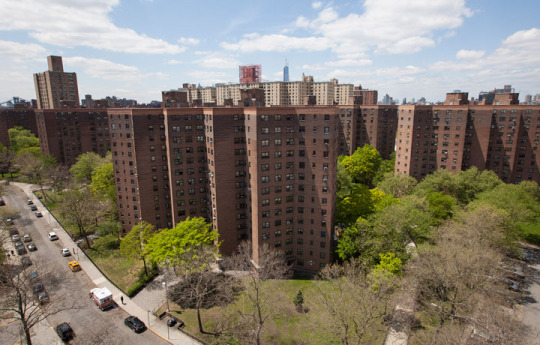
So I read the same articles that you've read, which mention that NYCHA just reported that they need $78 billion to repair and renovate their buildings, and that figure is almost double the $45 billion estimate from 2017. And then I read the actual report, which explains that $78 billion is how much NYCHA will need to spend over the next twenty years.
$78 billion divided by 20 is $3.9 billion a year. Now I don't want to minimize the problem: NYCHA's operating budget, which is separate from the NYC municipal budget, is about $4 billion a year and its capital budget is about $8 billion a year, so these repairs represent a significant additional cost burden for NYCHA. However, the NYC municipal budget is $107 billion a year - financing these repairs is not beyond the fiscal capacity of the City of New York, especially if it can get some assistance from the State Budget and HUD.
Counter-intuitively, I actually think this issue is an example of the costs of not spending money when it comes to public housing. As I've said before, trying to build public housing as cheaply as possible is actually counter-productive, because cheap construction runs down faster and increases maintenance and repair costs. In part what we are seeing now is the long-term consequences of the Federal Housing Acts of 1937 and 1949 and New York's state and city level housing laws requiring public housing to be built as cheaply as possible, as well as budgeting decisions made by NYC and NYCHA since the 1970s that have downplayed building new housing to replace the older stock and sought to save money from maintenance and repair budgets.
If instead NYCHA housing had been built to and operated at the same standards as similarly sized private apartment complexes that house New York's middle class and affluent residents, the buildings would be looking much better for their age - and NYCHA's repair bill would be much, much lower.
But to answer your question: it is absolutely possible for New York to build large amounts of high quality public housing, if it's willing to spend the money to do so, and the governor doesn't massively alienate the same progressive legislators and labor groups whose support they'll need to overcome suburban resistance to affordable housing.
And in terms of bringing down costs, I'd recommend that the state directly construct the housing rather than going through the traditional private contractors. (Also, if the state wants to really save money and be sneaky, instead of negotiating set-asides that merely designate a percentage of units as (temporarily) "affordable" in return for tax and regulatory benefits, have those negotiate a percentage of units as publicly-owned. Scatter-site housing via inclusionary zoning!)
39 notes
·
View notes
Photo

Update: Remember this post of an old basketball gym that was for sale in Wilkinson, Indiana for $299K?

Well, Kyle and Lauren were not looking for a new home when they saw the listing, and certainly had no interest in the rickety skeleton of a 72-year-old gym.

But because they lived nearby, they stopped in for a look. The pictures, they thought, had not done the space justice.
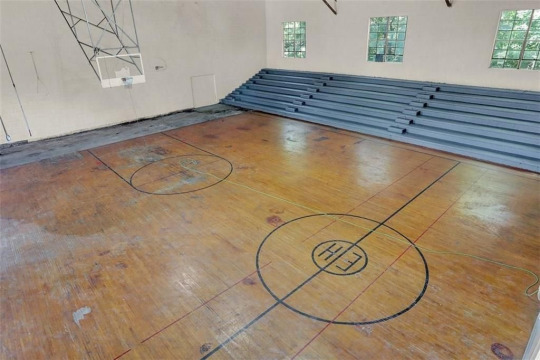
They were awed by its cavernous proportions, but they looked around and went home.

A week and a half later, the couple, (who has 3 kids), decided they wanted to own it. They called the real estate agent that morning and made an offer. It was accepted before they went to bed that night.

Lauren in front of the gym. “It was the strangest thing I’d ever heard of, and the coolest thing I’d ever heard of,” she said. The next day, after their offer of $300K was accepted, the real estate agent called and said the listing went viral and offers were pouring in from as far away as Singapore.
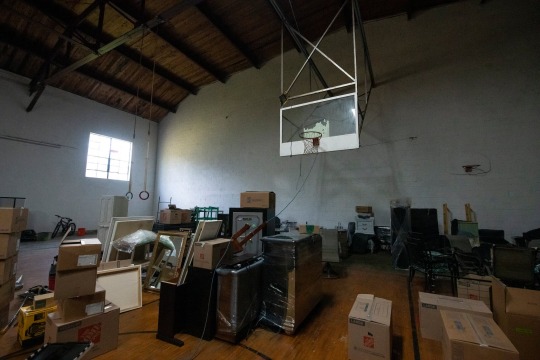
Among miscellaneous furniture, boxes await unpacking. Meanwhile, the viral moment faded as quickly as it appeared. The worldwide attention subsided.

Their daughter riding her bike in the gym. They realized one night that a colony of bats had taken up residence in the gym & spiders continue to emerge all over the house. Moving has been a slow process.

Kyle and his father examine carvings on an original wooden school desk left in the home. “We’re still walking around here thinking, ‘What did we just do?’” said Kyle, who estimated the cost of renovations, over a period of years, would eventually exceed the original cost of the home.

They have a photo showing the construction of the Wilkinson High School gym. They want to refurbish the court and open it up somehow to the Wilkinson community. The community is rooting for them and waiting to see what happens next.
https://www.nytimes.com/2022/09/24/sports/basketball/indiana-family-lives-in-gym.html
170 notes
·
View notes
Text
Ottawa's mayor is set to sign a pledge laying out how the city will help the Ontario government hit its ambitious targets for home construction in the coming decade.
Not doing so could affect whether the City of Ottawa receives funding to deal with the financial impacts of last fall's sweeping provincial housing legislation. City staff estimate the changes, such as waiving development fees on triplexes and affordable housing, could cost Ottawa $60 million a year by 2025.
The Ontario government announced last October it intended to build 1.5 million homes by the end of 2031, and assigned individual targets to 29 of the largest and fastest-growing cities and towns.
Full article
Tagging: @politicsofcanada
29 notes
·
View notes
Text
If you’re into UBI, you need to support Housing
I love the idea of a UBI. However, until we have enough housing, any additional money everyone starts getting will just go to increased housing costs. I.e. property values will go up, as will rent, moving that UBI income from the lower class to homeowners and landlords, while not improving the housing situation or life for most people. This is clearly not what we want to accomplish with a UBI.

We need to first build housing and then implement a UBI. (I imagine housing that is owned and run by local gov’ts or non-profit organizations, like housing authorities.) And considering the cost of a UBI, this is very feasible.
Let’s imagine a very modest UBI of $100/mo = $1,200/yr.
There are around 260 million americans over 18. If everyone got a UBI, that’d be over $260B/yr.
If we estimate housing construction costs of $260k/unit (just for convenience; the actual costs average only $200k), we can afford to build 1 Million apartments each year.
Estimates vary of how many homes are needed to satisfy housing demand in the US, with estimates varying between 3 to 8 million homes. Let’s round up to 10 million.
It would take just 10 years of our UBI setup to completely transform the housing crisis. That’s not a long time. And this was using very conservative figures. If we imagine a UBI of $1,000/mo (which many do), we could pay for all the housing from a single year’s budget!
And what do we get in return? Primarily, two major results:
a. People are housed: People have adequate housing; slow the progression of people into homelessness (caused by housing prices); improve rate of getting people out of homelessness. (And, ideally, guarantee housing for everyone.) Additionally, the price of housing will go down for everyone, benefiting the lower class tremendously. (Some economists have estimated that the price of housing in some places could come down as much as 10% with adequate housing supply. Imagine saving 10% on your rent!)
(It could potentially reduce the value of homes to some extent, which current property owners will not like, but I don’t think people are entitled to push for housing scarcity so that they can profit off it. Additionally, some studies show that things like changing exclusionary zoning can *increase* property values due to the fact that the same plot of land can now house more people.)
b. Money then put into a UBI is not swallowed by the upper class. The value of the money is more evenly enjoyed by all. Not to mention the savings from reduced housing costs (which could easily be $100/mo in savings). In other words, people will have more money, and the UBI becomes more effective.
It’s also worth noting that the investment into housing construction will actually pay for itself, as renters pay for use of the homes. Unlike a UBI, this investment produces dividends. Those funds can be reinvested in housing, other community needs, or used to help fund the UBI.
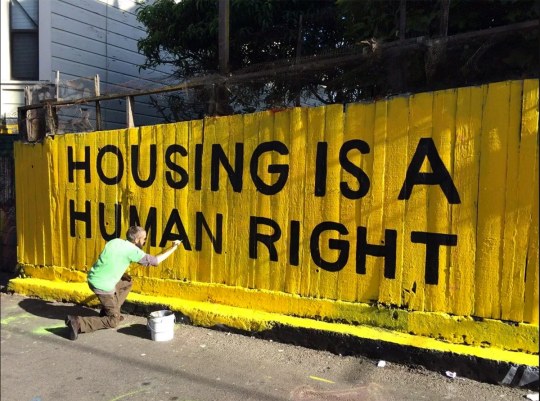
There is a lot of exploitation that happens in our capitalist system, but housing is by far the worst since it effects everyone (i.e. everyone needs a home) and is likely the most expensive part of everyone’s expenses, with many people seeing a third or more of their income going to this one expense, every month, till they’re dead.)
We must fix housing first. We must plug the hole in the ship before we can expect to move it forward with any efficiency. If you believe in a UBI, and understand the costs of it are worthwhile, then you need to also be advocating for a massive program to address the housing crisis.
19 notes
·
View notes
Text

Ditch the calculator and get an estimate of the construction materials required to build your dream home. Visit https://aashiyana.tatasteel.com/in/en.html and enter the specifications of your plot or house plan to get an instant estimate of rebars, roofing material and fencing wire required.
#building material calculator#house construction cost#house construction materials#house construction cost estimator#construction material suppliers near me#material required for house construction#home building contractors
0 notes
Photo

PEOPLE’S POLICY PROJECT
by Kendall Dix
The Flint, Michigan, water crisis has dramatically illustrated poor people’s lack of access to clean drinking water in the United States. But beyond lead contamination, there are more ways this country denies people that basic human right. The inability to pay water bills has become a significant problem for poor people.
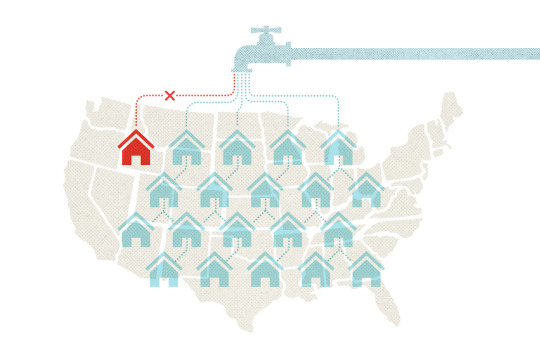
Even before the COVID-19 pandemic and accompanying economic downturn, an estimated 1 out of every 20 households, or about 15 million people, had their water turned off at some point during the year because of nonpayment.1 In New Orleans, more than 75 percent of low-income residents have water bills that industry analysts say are unaffordable.2 During the pandemic, an estimated 9,052 people died as a result of water shut-offs.3
Like all issues related to poverty, the problem of water affordability disproportionately harms Black people, making this a racial justice issue.4 The amount of household income spent on water is more than twice as high in majority Black cities as majority white cities.5

Most water for bathing, cooking, and drinking in the United States is provided by utilities, about 80 percent of which are publicly owned.6 Water utilities are funded by a combination of government money, user fees, municipal bonds, and private loans.7 Though household fees are often thought to discourage overuse, data show that demand for water is relatively fixed, and raising prices produces little reduction in usage.8 Furthermore, residential water use accounts for just 8.2 percent of overall water usage in the United States.9
The most effective and equitable solution to the affordability problem is to eliminate residential fees and simply fund water utilities entirely with progressive taxation. If governments are interested in reducing overall water consumption, there are a variety of other options such as physical infrastructure that limits the amount of water that flows through fixtures, water recycling, or limiting the largest users of water, which are farms and industrial facilities.

Two related, but distinct, problems characterize the term “water affordability”:
Poverty.
Many people in the United States have low amounts of income and no or negative wealth. This makes it difficult for them to afford their household expenses, including rent, food, and water utility bills.10 In addition to their inability to pay, poor people who have bad credit scores are often seen as risks to utilities, which force them to pay high deposits or sometimes even deny them water service altogether.11


(“Older Housing In The Black Community On Chicago's West Side.” U.S. National Archives / EPA. “Old Cars Serve as Water-Break on Navajo Reservation.” U.S. National Archives / EPA.)
Public Disinvestment.
Despite overall water consumption decreasing,12 people’s water bills are getting more expensive, in part because of decades of federal disinvestment from public infrastructure. Federal spending on water has dropped steadily since the 1980s.13 Utilities’ costs have risen, in part because of climate change,14 and those costs are passed on to the public through increasing rates.15 Private utilities, which serve about 20 percent of the population, exist to make a profit and have higher water rates than public utilities.16 As federal spending on water has fallen, private water utilities have been on the rise. From 2010 through 2020, just 12 large, for-profit water companies acquired 353 water utilities at a total cost of about $5.8 billion.17

Water rates function as consumption taxes that fund infrastructure projects, much like gasoline taxes help fund highway maintenance and construction.18 In theory, these taxes can be used to influence consumer behavior to decrease usage. In practice, households largely cannot and do not respond to increased water rates by reducing consumption.19 Replacing water bills with more progressive sources of funding would increase access and improve the income distribution without causing overuse.
Eliminating water bills not only ensures universal access for those with housing, it also lowers utilities’ costs by reducing the need for billing and collections staff. Fees and rates alone cannot maintain our water system; only about 17 percent of utilities say they can maintain existing service without additional funding sources.20

(“Public Playground on the Charles River, near Soldiers Field Road.” U.S. National Archives / EPA.)
Water utility costs can be broken down into two broad categories:

At present, capital expenses are often covered by loans taken out by utilities and repaid by the fees collected from water users. The main federal funding mechanism for drinking water is the State Revolving Loan Fund (SRLF), which provides low-interest loans to utilities. The SRLF provides useful financing for utilities across the country, but many smaller utilities struggle to pay those loans, and some states struggle to provide the required matching funds.
Water infrastructure did not always depend so heavily on loans. In the 1970s and early 1980s, the federal government provided significant grant money to water utilities. There are still a number of federal grant programs, including Water Infrastructure Improvements for the Nation Act (WIIN), Public Water System Supervision (PWSS), Tribal Public Water System Supervision, and Training and Technical Assistance for Small Systems.21
Congress should revive this approach and replace water infrastructure loans with grants. This would ensure that all utilities can afford to build out and maintain necessary infrastructure as well as eliminate the water rates that are used to directly or indirectly finance capital expenses.

Water utilities’ day-to-day expenses are currently distributed down to users through water bills. Replacing these charges with more progressive taxes would allow for the total elimination of residential water bills and result in a more equal distribution of income and consumption. Any level of government could do this. Municipalities could use property taxes to eliminate user charges, states could use state income or sales taxes, and the federal government could use the federal income tax. But if equality is the goal, it is worth noting that the federal tax system is currently much more progressive than state tax systems.22
This is not a new idea. Ireland does not charge residents for water and an effort to introduce charges in 2014 led to such immense backlash that the government scrapped them two years later.23 Some US cities have already begun experimenting with progressive water billing. For example, Philadelphia offers income-based water rates for those whose income is below 150 percent of the federal poverty line.24 Though this is good because it caps the amount any one household pays for its water bill, only households that apply are enrolled in the program. There are poor households that would qualify but are not receiving the benefit because they haven’t filled out the paperwork. Eliminating rates and fees altogether would be more effective.

(Continue Reading)
#politics#the left#peoples policy project#water#economic inequality#poverty#infrastructure#progressive#progressive movement#social democracy#democratic socialism#socialism#capitalism#economics#long post#long reads
21 notes
·
View notes
Text


At the general election on 23rd February 1950, the incumbent UK Labour government just managed to cling on by their fingernails, with a precarious single-figure majority…
Under Clement Attlee, Labour had won in a landslide in 1945 (145 seat majority), but by 1950 the wheels were, if not actually falling off, at least coming loose. The final result in 1950 was 315 seats for Labour, 298 for the Conservatives and nine for the Liberal Party. Opposition Leader Winston Churchill noted that the parliament would be in an ‘unstable condition’.
As the Attlee Government entered the final full year of its first term, the contentious Iron and Steel (Nationalisation) Bill was presented to parliament. This measure resulted in serious conflict with the Conservative Opposition, which had otherwise been generally supportive of the Government’s Welfare State reforms. The nationalisation programme was a source of disagreement, in particular iron and steel which was seen as profitable and efficient in private hands. (It would later be re-privatised by the Churchill government).
Cost of living pressures were also causing headaches, although the government asserted that food subsidies were saving the average family around 14 shillings per week. The peak inflation rate of 7.7% in 1948 improved to around 3% by 1949-50, but would spike again to around 9% in 1951. (1970s and 80s governments would have looked back at those inflation figures with teeth-grinding envy).
Health (and housing) Minister Aneurin Bevan said that the NHS was costing double what the Government had budgeted for. Other sources suggest that the blowout was as much as three times the initial estimates. Rationing was lifted on clothing, but high prices and low availability appeared to make little difference. Meat and butter rations were increased but the sugar ration was cut. A number of industrial actions disrupted essential services like transport, coal mining and the docks, the latter resulting in a declared State of Emergency.

The Government was also struggling to uphold a key component of its manifesto, rebuilding war-damaged housing and supporting slum clearances. Production and building targets were difficult to achieve because of the continued shortage of materials and labour. About 9 000 fewer permanent new homes were built in the first part of 1949 as had been constructed during the corresponding period of the year before. (Harold Macmillan would boost housing renewal under the Tories, although he was less hampered by labour and material shortages, and the construction of high rise flats was incentivised.)
Leading up to the 1950 election, the Liberal Party was calling for controls on spending, limits to nationalisations, the application of food subsidies based on need, and the curbing of an expanding bureaucracy and civil service. In their 1950 manifesto, they asserted;
“…Crisis upon crisis comes upon us, because we are living beyond our means. The Liberal Party believes passionately in full employment in a free society, and in maintaining the social services, but unless we practice thrift and get full production, lower rations and mass unemployment are inescapable when the American aid ends…”
Following a period of death, illness and disunity within government’s depleted ranks, the Conservatives returned to power when another general election was called in 1951. Labour would be out of office for 13 years, although many of their initiatives were embraced and even expanded by subsequent Tory governments.
#social history#uk politics#working class history#social justice#modern history#uk government#british culture#society#human rights#uk history
6 notes
·
View notes
Text
A report by the Turkish Enterprise and Business Confederation, TURKONFED, says the twin earthquakes registering 7.9 and 7.7 on the Richter scale on February 6 will likely cost the economy over 80 billion US dollars, equal to about 10 per cent of GDP.
“70.75 billion US dollars of this financial damage will be housing loss, 10.4 billion US dollar loss in national income and 2.91 billion US dollars loss of working days,” TURKONFED reported on Sunday’s Bloomberg HT. The group represents more 55,000 businesses.
The bill is equal to more than 10 per cent of Turkey total GDP, which was around 800 billion US dollars in 2021. The report also calculated that the likely death toll will in the end exceed 72,000.
Turkey’s Disaster and Emergency Management Presidency, AFAD, said it now believed at least 31,643 people lost their lives. The death toll in neighbouring Syria stood at least at 3,576 on Monday.
More than a week after devastating earthquakes struck the south and southeast of the country, many victims are still camping outdoors in freezing conditions.
Tent camps and prefabricated houses are being set by the government and NGOs as hundreds of thousands people leave the region for safer areas in other parts of the country.
Experts warn of a security and health crisis in the region.
UInder state of emergency decrees introduced over the weekend, President Recep Tayyip Erdogan has toughened the penalties for burglary and other criminal activities, including longer detention periods, in addition to health measures designed to prevent pandemics such as cholera.
Turkey’s August 17 1999 earthquake cost at least 20,000 lives and 17 billion US dollars in economic damage.
Justice officials on Sunday targeted more than 130 people allegedly involved in shoddy and illegal constructions which were destroyed by quakes and left people dead or dying under rubble.
19 notes
·
View notes